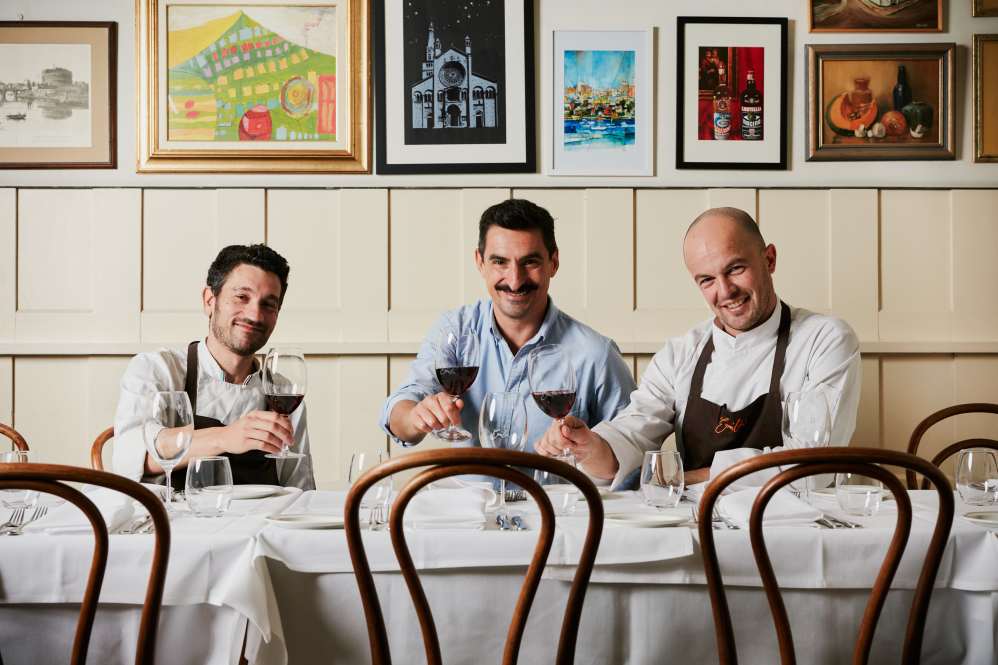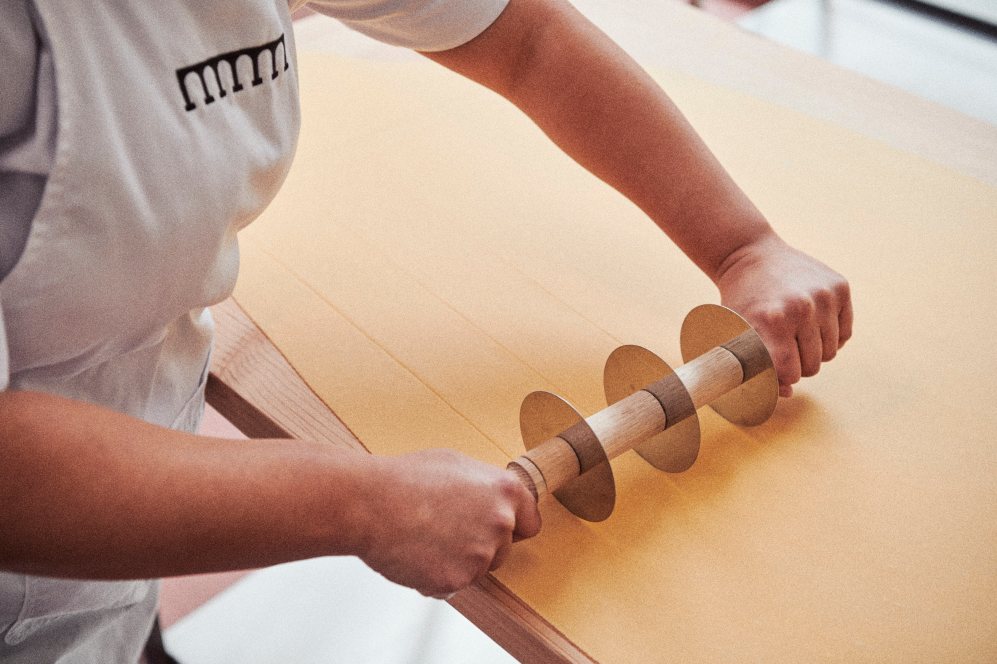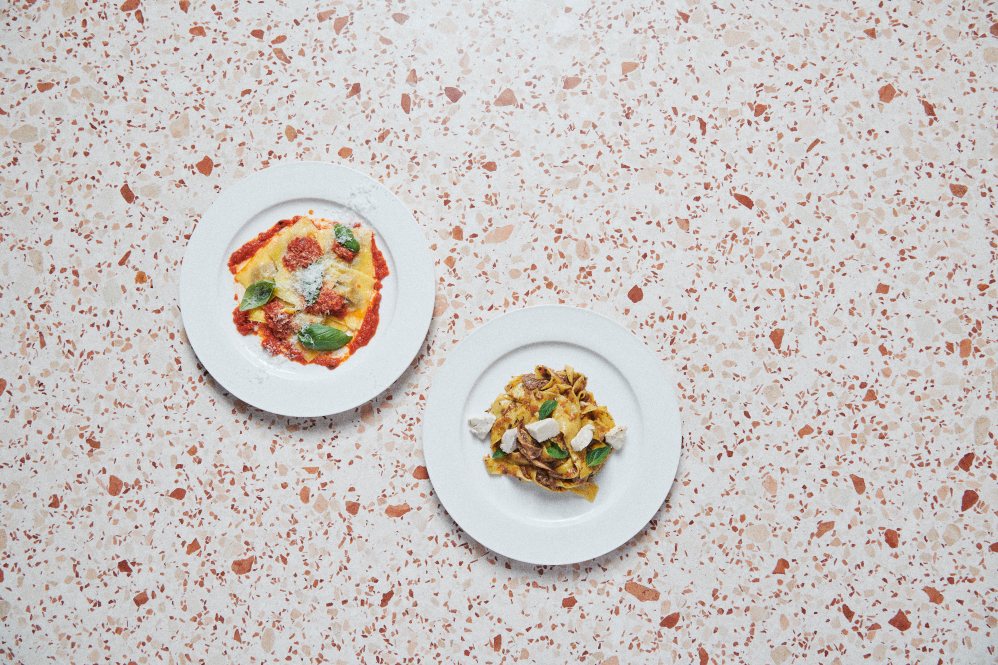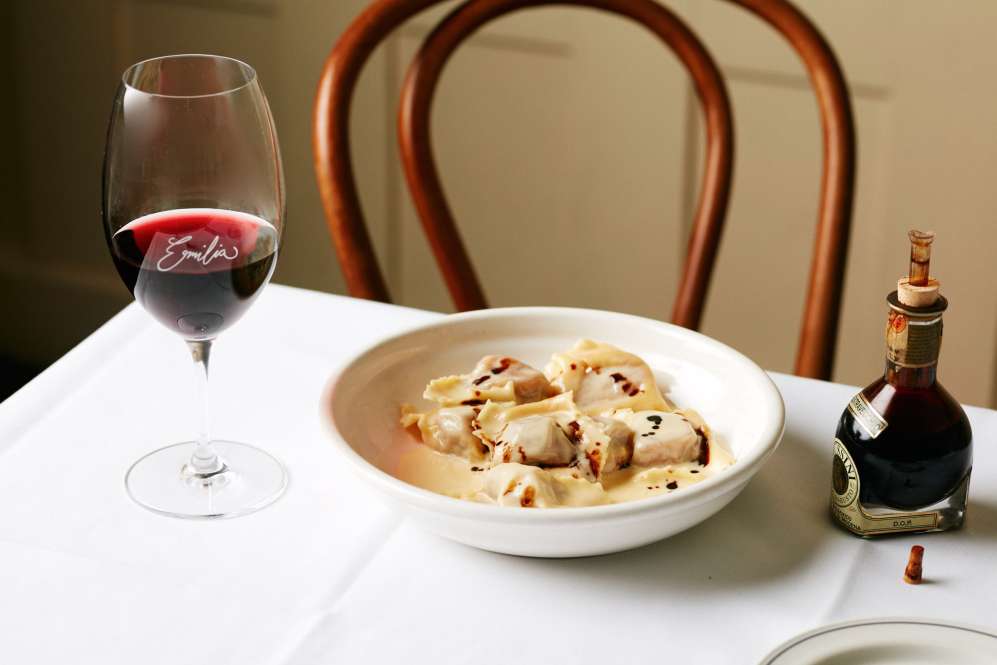A letter penned by an Italian merchant related a dish of pasta packed with minced green herbs, egg and fresh cheese served in a simmered broth dusted with spices. The 14th century record describes what we now know as ravioli.
Ravioli can be square or circular, filled with spinach or meat, served in a cheese-rich sauce or simmered in a light broth — and that’s just scratching the surface. While shapes such as mafaldine and cavatelli are commonplace on menus, there’s something to be said for a classic.
Hospitality speaks to Trattoria Emilia’s Francesco Rota and Pasta Poetry’s Elena Kavallarisa about the dough-making process, goto fillings and sauce options along with tips and tricks to ensure every ravioli makes it from the pan to the plate.
Ravioli has suffered somewhat of a tarnished reputation over the years, with subpar iterations seeing thick, chewy morsels of pasta overfilled with too many ingredients. It’s a huge stretch from the way ravioli is enjoyed in Italy.
Francesco Rota is from Modena in the Emilia- Romagna region, which is known for its balsamic vinegar and pasta, with the chef championing both elements at his Melbourne restaurant Trattoria Emilia. “In the north of Italy, fresh pasta is in our blood; we eat it all the time,” he says. “You see people making lasagne, tagliatelle or ravioli almost every day. You learn from your mum or nonna and it’s something we’re very passionate about.”
Trattoria Emilia’s current ravioli dish sees a ricotta and goat’s cheese option served with tomato reduction, rocket pesto and chilli. But first, the dough. Rota begins the process with semolina and flour imported from Italy. “When you open the bag of flour, you get the smell of the grains straight away and it gives a three-dimensional
flavour,” says the chef. “We use Molino Pasini and Petra flours, which have less water content. We try to avoid changing brands because then you have to tweak the recipe.”
The kitchen team combine 600g 00 flour and 400g fine semolina with 10 free-range egg yolks and five whole eggs in a planetary mixer. “The eggs are mixed beforehand and then we add them slowly to pull the flour together,” says Rota.
“Once it’s just combined and crumbly, we put the dough in a cryovac machine. If you overwork it, the dough becomes a pale-yellow colour and will retract when you roll it. This pasta is nice and bright and will last two to three days.”

Rota and his team rely on experience rather than a specific number on the pasta machine when it comes to rolling out the dough. One of the markers of pasta from the Emilia-Romagna region is its thinness. “My guys always ask about the number, and I say, ‘It doesn’t matter which number, every machine is different’,” says Rota.
“The tradition says you should be able to see your hand behind it, that’s how thin you want it to be. You also need it to be thin because when you fold it, you have two pieces of pasta together and it is harder to cook it all the way through if it’s too thick. It carries the filling just enough to get it from the fork to your mouth.”
Melbourne’s Pasta Poetry has become a hub for all things pasta, with Head Chef Elena Kavallarisa learning the art of pasta-making during a three-month stint in Bologna. Ravioli is one of the venue’s top sellers and fast became a crowd favourite. “You can make tiny raviolis or big raviolos and get a nice, generous filling in there,” says Kavallarisa. “They’re very versatile.”
Pasta Poetry’s ravioli offering covers spinach and ricotta along with a more non-traditional filling inspired by eggplant parmigiana. “The eggplant is crumbed in panko and soaked in sugo,” says Kavallarisa. “There’s burrata and fresh mint as well. It’s been flying off the shelves.”
The chef sticks with a uniform dough recipe for Pasta Poetry’s range, using Ben Furney Flour Mills’ product which is made from grains sourced within 200km of the mill in Dubbo’s Macquarie Valley. “We did a lot of testing with different flours and flours from Italy, and we found there wasn’t too much of a difference,” says Kavallarisa. “We want to support local businesses and most of our products are Australian.”
Flour and eggs are the only ingredients in Pasta Poetry’s dough, with the team using a bespoke piece of machinery from Italy that emulates a person using a fork, just as you would at home. “We have a 120-litre fork mixer that uses the same method,” says the chef. “It has two phases, and it doesn’t heat up the dough.”
Once the dough is kneaded, it’s portioned out into balls and left to rest for 30 minutes. “During that time, the bright colour comes through,” says Kavallarisa. “For ravioli, we sheet it at 0.3 on our robo-sheeter; it ends up being a 1.2-metre-long sheet of pasta. Ravioli is a lot thinner because of the double layer. It takes a while to roll it out; you need to have some patience.”

The way in which a pasta sheet is cut comes down to the desired end shape. Trattoria Emilia’s current ravioli dish sees the pasta cut into circles, with agnolotti — another stuffed pasta — cut into squares. Pasta Poetry has bespoke cutters that allow the team to eliminate the laborious task of individually cutting each shape out. “We have round standard cutters, but we also have custom rolling pin cutters with blades underneath,” says Kavallarisa. “As you roll, you cut three to four strips at a time and you have squares in a few seconds. It results in less wastage as well.”
Once the ravioli has been cut, it’s time to move on to the all-important interior. Everything from the dough to the pasta filling is weighed by Trattoria Emilia’s chefs, who pay close attention to sealing the morsels properly. “You push all the air bubbles out with the bottom of your hand and close the dough with the tip of a knife,” says Rota.
“Then we put them on a tray with some semolina to dry out a little bit. The most important thing is having enough filling; the second most important thing is having no air pockets when you fold them because they will explode in the boiling water.”
Kavallarisa recommends chefs leave two fingers between the stuffing and the edge of the pasta to achieve the right ratio. “You want to balance the pasta with the filling,” she says. “If it’s an intense filling, you don’t want to put too much in there, and if you over-pack it, it will open up and explode.”

The chef keeps a spray bottle filled with water close by to help the dough adhere together. “You need to make sure all the edges are as compact as possible and you’re getting all the air out,” says Kavallarisa. “If there’s air in it, it will float to the top straight away. It should sink when you put it in and float up when it’s cooked.”
While ravioli fillings vary considerably, the cooking time is determined by the dough rather than what’s inside. “Because it’s fresh pasta, it takes between five and seven minutes,” says Rota. “It’s more about cooking the pasta right; you want it to be soft
with a melting filling.”
Kavallarisa cooks Pasta Poetry’s ravioli for around four minutes. “It comes down to how much filling is inside,” says the chef. “We have a crab and scallop agnolotti, which is pretty much a square ravioli, that takes longer. You want to make sure the centre isn’t cold. When you finish it off with the sauce, it completes the cooking process.”
The interior of ravioli is arguably the star of the eating experience, but sauce still plays a pivotal role. In Italy, it’s a matter of less is more. “Modena’s most classic option is nutmeg, parmesan, ricotta and spinach ravioli served with melted butter and sage,” says Rota. “We usually toss the pasta through melted butter and then add parmesan. Or, you can boil some cream and add Parmigiano-Reggiano and Grana Padano.

“In the South of Italy, they use tomatoes; in Sardinia, they use a lot of mint and saffron; in Tuscany, they do butter, rosemary and poppy seeds and if you go to Liguria, they use a lot of pesto.”
Kavallarisa also tips butter and sage “with a tonne of cheese” as one of the most-loved sauce options. “We have a parmesan and egg-based sauce, too, but you want to keep it subtle as the hero is the filling,” says the chef. “The way we eat ravioli here is very intense with a lot of ingredients. In Italy, it’s kept simple with a butter sauce and maybe some truffle shaved over the top.”
The final part of the ravioli process is plating, and of course, eating. “When it comes to plating, we like it to look rustic and casual, almost like your nonna did it,” says Rota. “It looks simple, but there’s a lot of research and technique behind it.”
Filed under
Sponsored Content

Summer insurance essentials for mobile food truck owners
Sponsored by BizCover

Celebrating coffee moments with Buondi
Sponsored by Nestlé Professional
Trending Now
Resources
Lorem ipsum dolor sit amet, consectetur adipiscing elit. Fusce ac ornare lectus. Sed bibendum lobortis...
Lorem ipsum dolor sit amet, consectetur adipiscing elit. Fusce ac ornare lectus. Sed bibendum lobortis...
Sign up for our newsletter
